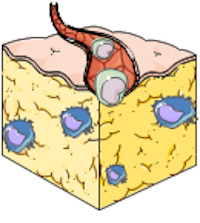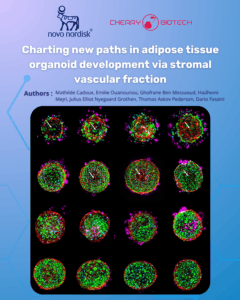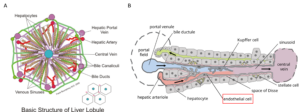Introduction
Adipose tissue functions are not only to store energy, it also governs the metabolism of cells and tissues around the body by secreting hormones, cytokines, proteins, and microRNA. Adipose tissue is divided into separate depots all over the body, which are differently linked to resistance to insulin and a greater risk of metabolic illness.
White adipocytes’ main job is the storage of energy. In their cytoplasmic lipid droplets, they store fat in the form of triglycerides that assist maintain blood-free fatty acid levels.

Adipose Tissue Function
Adipose tissue functions have for a long time been regarded as just passive fuel storage. It is now also an endocrine organ that secretes various bioactive components (hormones, growth factors, cytokines). Leptin (satiety factor) and adiponectin are key fat tissue hormones.
They circulate through the body and transmit information to other metabolic active bodies like hepatitis, pancreas, muscle, and brain. These factors are of key importance in the pathophysiology of many metabolic disorders (e.g. type 2 diabetes mellitus).
Adipose tissue is, in addition, exceedingly heterogeneous. Each depot has various physiological roles, diverse metabolic and hormonal characteristics. Therefore, the differential accumulation of certain deposits translates into various clinical results. Abdominal or core obesity, as compared to peripheral obesity, is more commonly related to cardiometabolism.
The adipose research field is fast-growing, notably driven by type 2 diabetes and obesity pandemics. A better understanding of their fundamental physio-pathologies, drug target identification, and drug development will require recapitulating this heterogeneity in in vitro 3D cell culture.
How to culture vascularized & immunocompetent 3D models in a standard Multiwell
Abstract of Adipocyte Heterogeneity Underlying Adipose Tissue Functions
Adipose tissue distribution in the human body is highly heterogeneous, and the relative mass of different depots is differentially associated with metabolic disease risk. Distinct functions of adipose depots are mediated by their content of specialized adipocyte subtypes, best exemplified by thermogenic adipocytes found in specific depots. Single-cell transcriptome profiling has been used to define the cellular composition of many tissues and organs, but the large size, buoyancy, and fragility of adipocytes have rendered it challenging to apply these techniques to understand the full complexity of adipocyte subtypes in different depots. Discussed here are strategies that have been recently developed for investigating adipocyte heterogeneity, including single-cell RNASeq profiling of the stromal vascular fraction to identify diverse adipocyte progenitors, and single-nuclei profiling to characterize mature adipocytes. These efforts are yielding a more complete characterization of adipocyte subtypes in different depots, insights into the mechanisms of their development, and perturbations associated with different physiological states such as obesity. A better understanding of the adipocyte subtypes that compose different depots will help explain metabolic disease phenotypes associated with adipose tissue distribution and suggest new strategies for improving metabolic health.
References
Yang Loureiro Z, Solivan-Rivera J, Corvera S. Adipocyte heterogeneity underlying adipose tissue functions. Endocrinology. 2021 Jul 5:bqab138. DOI: 10.1210/endocr/bqab138. Epub ahead of print. PMID: 34223880.
FAQ
Adipose tissue functions extend beyond just storing energy. It is also considered an endocrine organ. It controls the metabolism of cells and tissues around the body. This is done by secreting hormones, cytokines, proteins, and microRNA. The main job of white adipocytes is energy storage. They store fat in lipid droplets as triglycerides. This assists in maintaining blood-free fatty acid levels. Fat tissue hormones, such as leptin and adiponectin, are secreted. They circulate and transmit information to other metabolically active bodies like the liver, pancreas, muscle, and brain. These factors are very important in the pathophysiology of many metabolic disorders.
Adipose tissue is divided into separate depots around the body. These depots are linked in different ways to insulin resistance and a greater risk of metabolic illness. The tissue is exceedingly varied. Each depot has distinct physiological roles. The metabolic and hormonal characteristics are also diverse. Because of this, the differential accumulation of certain deposits results in different clinical outcomes. For example, abdominal or core obesity is more commonly related to cardiometabolism when compared to peripheral obesity. The relative mass of these different depots is associated with metabolic disease risk in different ways.
Single-cell transcriptome profiling is a technique used to define the cellular composition of tissues. The application of these techniques to understand the full complexity of adipocyte subtypes has been difficult. This is because of the characteristics of adipocytes. These cells are large in size. They also have high buoyancy and are fragile. These properties have made it difficult to apply the techniques to mature adipocytes. This difficulty has hindered the study of the different adipocyte subtypes found in different depots.
New strategies have been recently developed to investigate the variation between adipocytes. One strategy involves single-cell RNASeq profiling. This is applied to the stromal vascular fraction of the tissue. This method is used to identify diverse adipocyte progenitors. Another strategy is single-nuclei profiling. This technique is used to characterize the mature adipocytes. These efforts are helping to create a more complete characterization of adipocyte subtypes in different depots. They also provide information on their development mechanisms. Perturbations associated with states like obesity are also being studied. A more complete profile of adipocyte subtypes will help explain metabolic disease phenotypes.




